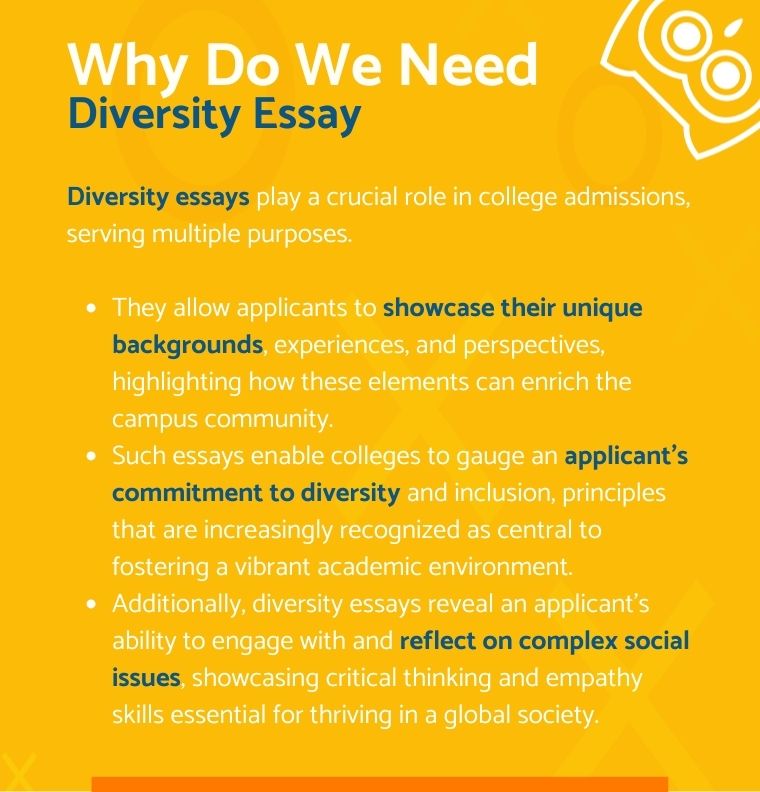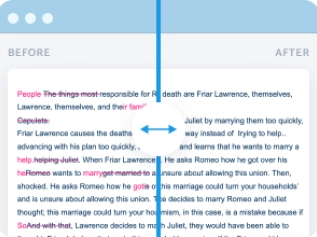How to Write a Diversity Essay
Table of contents
A diversity essay is a personal statement that explores the you, your experiences, perspectives and values that you bring to the table and how those impact the academic and social environment of the college. It’s where you get to show the different aspects of who you are, culture, background, experiences and challenges you’ve overcome.
Key takeaways:
- A diversity essay is about you, how your experiences shape your worldview and approach to learning.
- Purpose: colleges want to know how you will contribute to their diverse community.
- To write a diversity essay, choose a meaningful topic, structure your essay with a strong introduction, body, and conclusion, focus on storytelling, and be authentic and reflective in sharing your experiences.
This will help you write a diversity essay that meets academic standards and tells your unique story in a powerful way. Let’s get started!
Definition of a Diversity Essay
In the world of college apps and scholarship essays, the diversity essay is the ultimate tool to show off your awesomeness and perspectives.
What is diversity essay? It’s a thoughtful piece that digs into the unique parts of you and your experiences and how they contribute to the diversity of a community or institution. This essay is not just about racial or ethnic differences; it’s about cultural, religious, socioeconomic, experiential diversity and more.
Writing such an essay requires deep self-reflection. It’s a process of looking inward and understanding the many facets of your identity college essay and how they have shaped your life. This self-reflection is not just about recognizing differences but also about appreciating the richness those differences bring to your life and by extension to the community you are a part of.
The importance of a diversity essay lies in its ability to make us understand the many human experiences that shape our world. It makes us appreciate the tapestry of existing backgrounds, beliefs and perspectives.

Selecting Your Focus
Moving forward from understanding the importance of diversity, the next step involves articulating your unique perspective. Choosing the right aspect of diversity to write about in your essay is critical. To make this choice, consider the following tips:
- Reflect on What Makes You Unique: This could be your cultural heritage, a unique life experience, or an unusual hobby or talent.
- Assess the Impact: Consider choosing an aspect that has significantly impacted your personal development.
- Look for Overlaps with Broader Themes: This linkage can provide a powerful context for your personal narrative.
Your essay should strike a balance between personal anecdotes and broader social and cultural implications.
- Avoid clichés and delve into unique, personal narratives and a fresh perspective in your paper on diversity.
- Authenticity is key; your essay should genuinely express your experiences and views, rather than rehashing common or stereotypical stories.
You can create compelling and insightful diversity essay topics by focusing on what makes your story distinct and connecting it to broader themes.
Planning the Diversity Essay
Now that you have your angle, the next step is to lay down a structured essay plan.
Planning for a diversity essay is just as important as writing a college admission essay. Understanding how to write a diversity statement and the importance of an outline can’t be overstated.
An outline is a roadmap, organizing your thoughts and stories in a logical order. It helps you to arrange your ideas in a logical flow so each point leads into the next.
The essay is usually divided into three main parts: an introduction, body and conclusion.
- The introduction should grab the reader’s attention and give a preview of what the essay will cover. It sets the tone and context for your story.
- The body is where you go into the details of your unique experiences and perspectives using a diversity essays sample to support your points. Each paragraph should focus on a different aspect of your diversity, building on the thesis statement.
- The conclusion ties everything together, reiterates the main points and leaves the reader with something to think about.
Having a clear and concise thesis statement is key to guiding your essay. A good one ensures everything in your essay supports the overall message you want to convey.
In short, planning, structured writing and a clear thesis is the key to a great college diversity essay.
Introduction
Your introduction is key to hooking your reader.
Start with a strong statement, anecdote or question that sums up your diverse background or perspective. This could be a descriptive paragraph of a key moment, a brief story of a personal experience that changed your understanding of diversity or a unique insight that’s you.
The tone you set in the introduction is important. It should match the theme of your essay and give a hint of the tone you’ll use.
The introduction should capture and provide context for your story. It should give a glimpse into the aspects of your identity or experiences you’ll be exploring in the essay.
Remember, this is your first impression so make it reflective, engaging and a taste of the great story to come.
Body
Now that you have your reader’s attention, it’s time to get into the meat of your essay.
The body of your diversity scholarship essay is where you bring your unique experiences and perspectives to the table. When sharing personal stories and experiences that highlight diversity, remember:
- Focus on specific instances or experiences that clearly show the diversity you’re talking about. Vivid details make your story more interesting and relatable.
- Use anecdotes and examples to show how your experiences have shaped your views on diversity and inclusion, not just state them.
- While your stories are personal, try to connect them to bigger themes or issues related to diversity, so the reader can see the bigger picture.
Think about how your experiences have changed your understanding of diversity and what you’ve learned from them. Also, share how diversity and inclusion essay is important in your life and broader society.
Balancing storytelling with analytical and reflective writing is key to a good piece. While your stories bring the diversity college essay to life, analytical and reflective writing gives depth and context.
Conclusion
A good conclusion is key to leaving your reader with something to think about. Try:
- Summarise the main points.
- Go back to the introduction.
- Briefly think about the bigger picture. How does your diversity contribute to a broader societal or community context.
- Leave with a thought provoking statement. End with a question or a statement that makes the reader think.
A good conclusion not only sums up your main points but also reflects on the wider significance of your diverse experience. This is your chance to make a meaningful impact and to stress the value of diverse experiences and perspectives in understanding the world.
Common Diversity Essay Challenges
Writing an effective diversity essay means navigating many complex and sensitive issues. Understanding and addressing these challenges is key to a respectful and meaningful essay:
- Sensitivities: Diversity topics touch on very personal and potentially sensitive issues. When writing diversity and racism essay topics, be aware of the nuances and complexities involved in talking about race, ethnicity, gender, sexuality, religion and other aspects of identity. These topics require careful handling and thoughtful analysis to have respectful and meaningful conversation.
- Avoid Stereotypes and Generalizations: Make sure your essay shows a nuanced understanding of diversity, recognising that each person’s experience is unique and can’t be broadly categorised.
- Balancing Adversity: While discussing challenges and adversity can be a powerful part of your essay, overemphasising struggle can overshadow other important parts of your diversity experience. Try to balance acknowledging adversity and growth, strengths and positive outcomes.
- Avoiding the Prompt: It’s easy to fall into the trap of just restating the essay prompt or question in your response. Instead use the prompt as a starting point for a deeper exploration of your own experiences and perspectives.
- Authenticity and Respect: Be mindful of how others will read your words, especially those from different backgrounds or experiences.
By being aware of these challenges you can write a meaningful and respectful diversity essay. It’s about finding the balance between personal narrative and broader social understanding without oversimplifying or generalising.
Diversity Essay Example
Here is an example of a diversity essay that shows an individual’s journey from limited understanding of diversity to deep appreciation of the many cultures, religions and backgrounds they have encountered through personal experiences.
What makes me diverse?
Growing up in a small, predominantly white town in the Midwest, my understanding of diversity was limited to what I saw on television and read in books. It wasn’t until my family moved to a larger city that I experienced the true mosaic of cultures, religions, and backgrounds. This transition was eye-opening and challenging. I navigated various social norms and cultural nuances entirely foreign to me.
In school, I was one of the few students from a small town. My classmates hailed from various corners of the world, each bringing unique perspectives and experiences. Initially, I felt improper. I struggled to understand different accents and cultural references. However, I soon realized that this diversity was a gift. I learned about Diwali and Eid celebrations, tasted authentic dishes from countries I had only read about, and heard firsthand accounts of life in places I had never visited.
I also encountered diversity in thoughts and beliefs. Debates in my history class were no longer one-sided; they were enriched with multiple viewpoints, challenging my preconceptions and broadening my understanding of the world. I learned that diversity isn’t just about racial or ethnic differences; it’s about the exchange of ideas, experiences, and values.
My journey of embracing diversity wasn’t without challenges. There were moments of cultural misunderstandings and unintentional offenses. These experiences taught me the importance of empathy, open-mindedness, and communication. I learned to ask questions instead of making assumptions, to listen more than I spoke, and to embrace my role as a learner in the vast classroom of diverse experiences.
Outside of school, I volunteered at a local community center, where I worked with refugees. This experience was transformative. I heard stories of resilience in the face of unimaginable adversity, saw the challenges of assimilation, and understood the profound impact of cultural identity. These interactions deepened my appreciation for the complexities and strengths inherent in diverse communities.
Reflecting on these experiences, I recognize how my background in a small town and my exposure to a diverse urban environment have shaped my perspective. I understand that diversity is not just about co-existing; it’s about actively engaging with and learning from others. Diversity is an opportunity to expand our understanding, challenge our assumptions, and grow in ways we never anticipated.
This diversity essay is good for several reasons.
- Firstly it shows how personal experiences can shape one’s understanding of diversity.
- Secondly it shows that diversity goes beyond race and ethnicity; it’s a range of experiences, beliefs and values.
Also the essay balances personal narrative with broader reflections on the importance of diversity. The author’s personal stories are woven seamlessly with insights on the value and challenges of diversity. These are key to having inclusive and respectful interactions in a diverse society.
In summary this personal diversity essay example is a nuanced and reflective piece on diversity. It shows the power of exposure to different cultures and ideas and that diversity is the path to personal and collective growth.
Summary
An impactful diversity essay is about authenticity, self reflection and respect. These are the rules that govern the structure of your essay so your story is true and deep.
A good diversity essay weaves these together to tell a personal story that contributes to the bigger conversation about diversity.
It should foster empathy, understanding and reflection not just about your own experiences but about the importance of diversity in creating a more inclusive and empathetic world.
By sharing our individual stories with authenticity, contemplation and respect we can build a greater awareness of the vast human experience that surrounds us.







